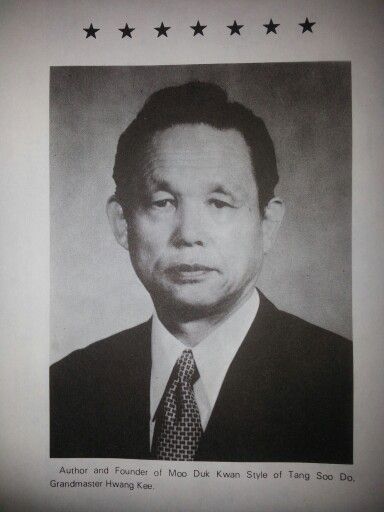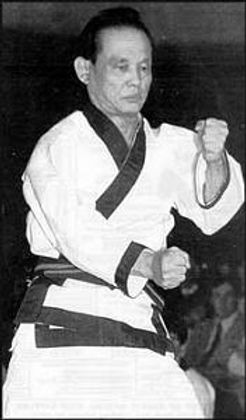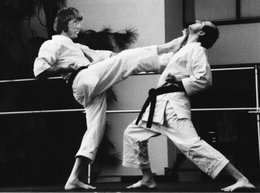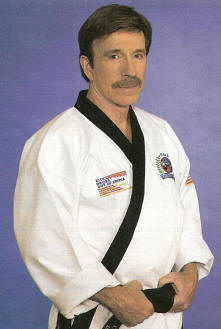History of Tang Soo Do

Welcome to the History of Tang Soo Do. The name Tang Soo Do is the Korean pronunciation of the Chinese characters 唐手道 (Tung Shou Dao). Most of all Tang Soo Do literally means “China Hand Way” (the “Tang” refers to the Tung Dynasty). Similar characters are pronounced karate-dō in Japanese.
The first character, 唐 (which initially referred to China), was later changed to 空 by Gichin Funakoshi to mean “empty” rather than “China” (空手道, or Kong Shou Dao. And the Korean pronunciation of these characters is Kong Soo Do). Outside of the Far East, the term “Tang Soo Do” has primarily become synonymous with the Korean martial art promoted by Hwang Kee.
History of Tang Soo Do
Therefore most schools of Tang Soo Do use the transcription “Tang Soo Do”. However, scientific texts apply the official transcription “tangsudo”, written as one word. Likewise some authors write “Tang Soo Do” and give “tangsudo” or “dangsudo” in the parenthesis.
In addition under the Korean government’s Revised Romanization System (officially adopted in July 2007) the martial art’s name would be rendered “Dang Su Do”.
Importantly Lee Won Kuk (1907-2003)is credited as being one of the first instructors of Tang Soo Do in Korea. Also in early 1944 Lee Won Kuk had an established dojang in Korea during the Japanese occupation of Korea. Very importantly the school was called the Chung Do Kwan, or “Blue Wave School”.
History of Tang Soo Do
And according to Lee Won Kuk, this name was chosen to reflect its connection to the Shotokan, or “Pine Wave School.” Lee Won Kuk received Dan ranking from Funakoshi Gichin in Japan. Therefore after graduating from Central University in Tokyo he continued his studies in Shotokan. And as well as traveling to Okinawa and China to further his martial art training. However he also purportedly studied taekkyeon in An Gup Dong, Seoul, Korea and Kung Fu in Henan and Shanghai, China. But some argue that Hwang Kee was a student of Lee Won Kuk. and later Won Kuk Lee was also instrumental in developing the Korean martial art of Taekwondo.
Moo Duck Kwan

Importantly the history of the Moo Duk Kwan (from which most Tang Soo Do stylists trace their lineage) can be traced to a single founder: Hwang Kee (1914-2002).
And Hwang Kee learned Chinese martial arts while in Manchuria. Most importantly he also was influenced by the indigenous Korean arts of taekkyeon and subak.
Consequently Hwang Kee learned much of the Moo Duk Kwan curriculum from a text on Okinawan Karate, presumably written by Gichin Funakoshi. In 1957.
Hence Kee made a discovery of Korean martial techniques in a text entitled the, “Muye Dobo Tongji.” Hwang Kee developed these techniques into formal exercises that are now part of the martial art of Soo Bahk Do Moo Duk Kwan and many, but not all styles of Korean Tang Soo Do.
Grand Master Hwang Kee opened his first school, (the Moo Duk Kwan), on November 09, 1945. And he originally called his style Hwa Soo Do (Hwa Soo Do Moo Duk Kwan) which was later changed to Tang Soo Do (Tang Soo Do Moo Duk Kwan). Today his Association is called Soo Bahk Do Moo Duk Kwan.
According to Hwang Kee, the ancestral art of Korean Soo Bahk Do can be traced back to the period when Korea was divided into three kingdoms: Silla, Baekje, and Goguryeo.
Ancient History of Tang Soo Do
Goguryeo was founded in 37 BCE in northern Korea. The Silla Dynasty was founded in 57 BCE in the southeast peninsula. The third kingdom, Baekje (sometimes written “Paekche”) was founded in 18 BCE. As a result after a long series of wars, the Silla Dynasty united the three kingdoms in 668 CE.
Also during this period, the primitive martial arts (including an art known as Subak) were very popular as a method of self-defense in warfare. Among the three kingdoms, the Silla Dynasty was most famous for its development of martial arts. A corps composed of a group of young aristocrats who were called “Hwarang” (화랑) was the major force behind the development of the art. Therefore these warriors were instrumental in unifying the Korean peninsula under the new Silla Dynasty (668 – 935 CE). Most importantly many of the early leaders of that dynasty were originally members of the Hwarang. Above all most Korean martial arts trace their spiritual and technical heritage to this group.
Certainly an important Korean martial arts book was written in 1790, the “Muye Dobo Tongji,” And its illustrations show that the Korean martial arts had developed into a very sophisticated art of combat. Although it was popular among the public, it was eventually banned by the Joseon Dynasty, (which succeeded the Goryeo kingdom), due to fear of rebellion.
Legacies
Therefore, the Korean traditional martial arts were taught as one teacher to only one student throughout the teacher’s life. During the Japanese occupation, students were forced to train in secret. Most of all Hwang Kee left Korea at this time and ventured into Manchuria. There he came into contact with the Chinese Tung System. Hwang Kee eventually incorporated the flowing and graceful motions of the Tung system with the linear, strong movements of Karate Do. And the diverse kicking of Taekkyon. And this blend resulted into what is currently known as Soo Bahk Do.
During the Japanese occupation of Korea (1910–1945), Korean culture, including military history and martial arts, were destroyed or heavily restricted. And some Koreans were exposed to Okinawan martial arts such as Karate-Do. Most of all as the Japanese moved deeper into the continent, Karate was adopted and practiced from the philosophical perspective. And that reflected the traditional Korean martial arts such as taekkyeon and subak. Also traditional Chinese martial arts studied by Koreans in Manchuria and China.
History of Tang Soo Do continues
Therefore around the time of the liberation of Korea in 1945, five martial arts schools called the Kwans were formed by men. Importantly these men who were primarily trained in some form of karate. But also had exposure to taekkyeon and kungfu. The five prominent Kwans (and respective founders) were: Chung Do Kwan (Lee Won Kuk), Jidokwan (Chun Sang Sup), Chang Moo Kwan (Lee Nam Suk and Kim Soon Bae), Moo Duk Kwan (Hwang Kee), and Song Moo Kwan (Ro Byung Jik).
For instance these schools taught what most Americans know as “Korean Karate.” However, there were some philosophical differences in technique application. And more of an emphasis on kicking in the Tang Soo Do Jido/Chung Do/Chang Moo/Moo Duk/Song Moo Kwan systems. In other words the history of Tang Soo Do is very rich!
Modern Times

Continuing the History of Tang Soo Do. Around 1953, shortly after the Korean War, four more annex Kwans formed. These 2nd generation kwans and their principle founders were: Oh Do Kwan (Choi Hong Hi and Nam Tae Hi), Han Moo Kwan (Lee Kyo Yoon), Kang Duk Won (Park Chul Hee and Hong Jong Pyo) and Jung Do Kwan (Lee Young Woo).
And in 1955, these arts, at that time called various names by the different schools. They were ordered to unify by South Korea’s President Syngman Rhee. A governmental body selected a naming committee’s submission of “Taekwondo” as the name. Both Sun Duk Song and Choi Hong Hi claim to have submitted the name.
In 1959, the Korea Taekwondo Association was formed in an attempt to unify the dozens of the kwans as one standardized system of Taekwondo. The first international tour of Taekwondo, by General Choi Hong Hi and Nam Tae Hi (founders of the Oh Do Kwan). And including 19 black belts, was held in 1959.
Continues...
Consequently in 1960, Jhoon Rhee was teaching what he called Korean Karate (or Tang Soo Do) in Texas, USA. After receiving the ROK Army Field Manual (which contained martial arts training curriculum under the new name of Taekwondo) from General Choi. Joon Rhee began using the name Taekwondo. Therefore there are still a multitude of contemporary Taekwondo schools in the United States that teach what is known as “Taekwondo Moo Duk Kwan”. This nomenclature reflects this government-ordered Kwan merger.
History of Tang Soo Do continues
Modern Taekwondo schools with the Moo Duk Kwan lineage often practice the early Tang Soo Do curriculum. Which is a curriculum that was more closely associated with Karate-Do Shotokan.
And despite this unification effort, the kwans continued to teach their individual styles. For instance, Hwang Kee and a large constituent of the Moo Duk Kwan continued to develop a version Tang Soo Do. And that eventually became what is now known as “Soo Bahk Do Moo Duk Kwan”.
This modified version of Tang Soo Do incorporates more fluid “soft” movements reminiscent of certain traditional Chinese martial arts and kicking techniques rooted in Korean taekkyeon. Other modern Tang Soo Do systems teach what is essentially Korean Karate in an early organized form.
Associations
But some Tang Soo Do Associations and Federations, teach systems of Tang Soo Do that existed before the Taekwondo “merger.” And also before the development of modern Soo Bahk Do Moo Duk Kwan. These versions of Tang Soo Do are heavily influenced by Korean culture. And also appear related to Okinawan Karate as initially taught in Japan by Funakoshi Gichin.
As mentioned above, the term “Tang Soo Do/Dangsudo” was initially a Korean pronunciation of “The Way of The Chinese Hand”. In Japan, 唐手道 was pronounced “karate-do” (“The Way of The Chinese Hand”). And these characters initially reflected historical origins of the arts. However, the term “Tang Soo Do” has evolved to currently describe a form of Karate that is distinctly Korean, but is different than Taekwondo.
Today
Above all Tang Soo Do continues to expand and flourish under numerous federations. And with organizations that, for various reasons, separated from the Moo Duk Kwan. It can be argued that Tang Soo Do is one of the most widely practiced martial arts in the United States. Most of all there is no official census of martial arts practitioners exists.
Certainly due to political in-fighting and splintering, Tang Soo Do is not as unified as Tae Kwon Do. Though there is no large umbrella organization for Tang Soo Do practitioners. However the Amateur Athletic Union Taekwondo recognizes Tang Soo Do ranks. And permits Tang Soo Do hyeong in competition. Very importantly they also hosts non-Olympic style point-sparring to accommodate the various traditional Korean stylists.
Influential People

Tang Soo Do has many influential people. Many Grand masters in the west who were part of the Taekwondo wave were in actually masters of Tang Soo Do.
My Grand Master instructor was a Hapkido man, not a Taekwondo man.
However the most important, and influential man who is a Tang Soo Do master is Chuck Norris. He helped to put Tang Soo do on the map in the west.
And he continues to be a positive influence in the martial arts world today.
Researched by Sensei Kara Borshuk
Edited by Grand Master Art Mason